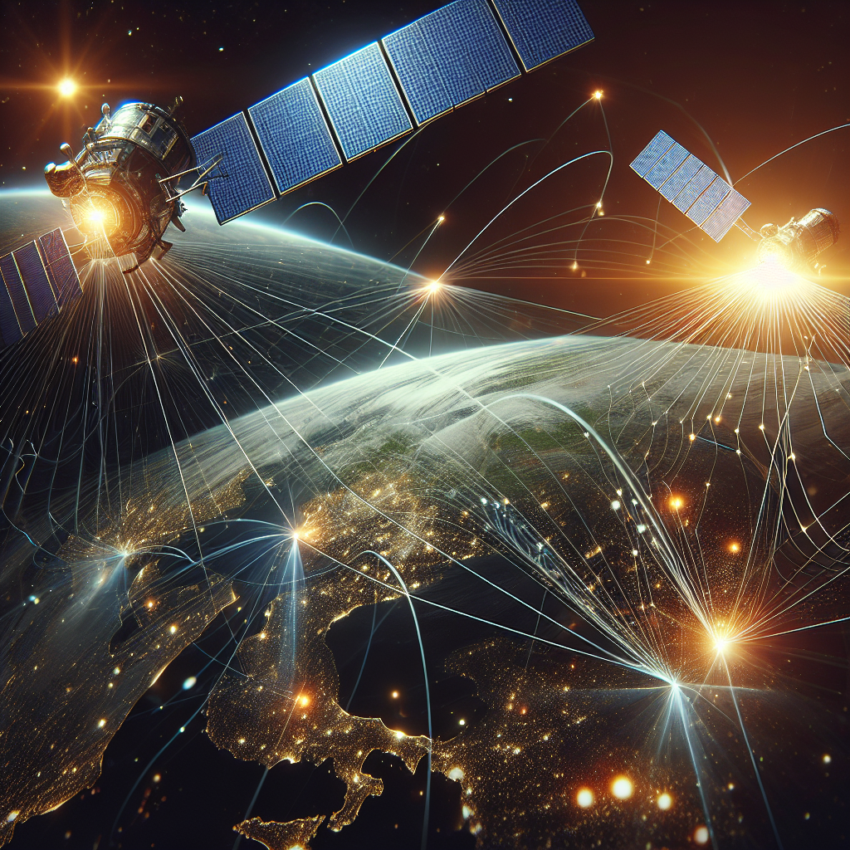The race to provide high-speed internet to every corner of the globe is heating up, with two major players leading the charge: Amazon and SpaceX. These tech giants are making significant strides in the development of satellite internet services, aiming to bridge the digital divide and bring connectivity to even the most remote areas. In this article, we delve into the latest developments in satellite internet services by Amazon and SpaceX, examining their respective projects, the technological advancements driving these initiatives, and the potential impacts on the global internet landscape.
The Visionaries: Amazon and SpaceX
Amazon and SpaceX are not just companies; they are visionary entities driven by the goal of transforming the way we connect to the internet. Jeff Bezos, the founder of Amazon, has long been passionate about leveraging technology to solve global challenges, and his Project Kuiper is a testament to that vision. Similarly, Elon Musk, the CEO of SpaceX, has been pushing the boundaries of what is possible with his Starlink project. Both initiatives aim to provide high-speed, low-latency internet access to underserved regions, revolutionizing the way we live, work, and communicate.
Project Kuiper: Amazon’s Satellite Internet Initiative
Amazon’s Project Kuiper is a ambitious plan to deploy a constellation of 3,236 satellites in low Earth orbit (LEO). The project, announced in 2019, has already received approval from the Federal Communications Commission (FCC) and is well on its way to becoming a reality. The satellites are designed to provide internet coverage to areas that currently lack reliable connectivity, including remote and rural regions.
Key Features of Project Kuiper:
- High-Speed Internet: Project Kuiper aims to deliver internet speeds of up to 400 Mbps, which is more than sufficient for most household and business needs.
- Low Latency: By placing the satellites in LEO, Amazon can significantly reduce latency, ensuring a smoother and more responsive internet experience.
- Global Coverage: The constellation will provide coverage to areas that are currently underserved or unserved, including parts of the United States, Canada, Mexico, and other regions around the world.
- Cost-Effective Solutions: Amazon is working to develop affordable and user-friendly terminal devices, making it easier for consumers and businesses to access the service.
Challenges and Progress: Despite the ambitious goals, Project Kuiper faces several challenges, including the technical complexities of launching and maintaining a large constellation of satellites, regulatory hurdles, and competition from other providers. However, Amazon is making steady progress. In 2022, the company successfully launched its first two prototype satellites, KuiperSat-1 and KuiperSat-2, marking a significant milestone in the development of the project.
Starlink: SpaceX’s Satellite Internet Network
SpaceX’s Starlink is perhaps the most well-known satellite internet service, and for good reason. Launched in 2019, Starlink has already deployed over 3,000 satellites, with plans to expand the constellation to over 42,000 satellites in the future. The project aims to provide high-speed, low-latency internet to users in both urban and remote areas, with a particular focus on underserved regions.
Key Features of Starlink:
- High-Speed Internet: Starlink currently offers internet speeds of up to 100 Mbps, with plans to increase this to 300 Mbps and beyond. The service is designed to support a wide range of activities, from streaming high-definition content to online gaming and video conferencing.
- Low Latency: By placing the satellites in LEO, SpaceX has managed to reduce latency to around 20-40 milliseconds, which is comparable to traditional fiber-optic internet.
- Global Coverage: Starlink is rapidly expanding its coverage, with the goal of providing global internet access by the end of 2023. The service is already available in over 30 countries, including the United States, Canada, the United Kingdom, and Australia.
- User-Friendly Equipment: SpaceX has developed a compact and easy-to-install user terminal, known as the Starlink Dish, which can be set up in minutes. The company has also introduced a mobile version of the terminal, enabling users to access the internet on the go.
Challenges and Progress: Starlink has faced its fair share of challenges, including concerns about space debris, the impact on astronomical observations, and the high cost of the user terminal. However, SpaceX has been proactive in addressing these issues. The company has introduced design changes to reduce the visibility of the satellites and is working with astronomers to mitigate any potential impact on scientific research. Additionally, SpaceX has launched a beta program to test the service and gather feedback from users, which has been instrumental in refining the technology and improving the user experience.
Comparing Project Kuiper and Starlink
While both Project Kuiper and Starlink aim to provide satellite internet services, there are some key differences in their approaches and capabilities:
- Number of Satellites: Starlink has a much larger constellation, with plans to deploy over 42,000 satellites, while Project Kuiper aims to launch 3,236 satellites.
- Current Coverage: Starlink is already operational in many countries and has a larger user base, while Project Kuiper is still in the development phase and has not yet launched a commercial service.
- Speed and Latency: Both services aim to provide high-speed, low-latency internet, but Starlink currently offers faster speeds and lower latency, thanks to its larger and more mature constellation.
- Cost: Starlink’s user terminal is more expensive than the planned terminal for Project Kuiper, but Amazon is working to develop a more affordable solution.
Impact on the Market: The entry of Amazon and SpaceX into the satellite internet market has significant implications for the industry. Traditional internet providers are being forced to innovate and improve their services to remain competitive. Additionally, the increased availability of high-speed internet in underserved regions has the potential to bridge the digital divide and drive economic growth in these areas.
Future Prospects and Innovations
As Project Kuiper and Starlink continue to evolve, both Amazon and SpaceX are exploring new innovations and partnerships to enhance their services. Some of the future developments to watch for include:
- Increased Capacity: Both companies are planning to increase the number of satellites in their constellations, which will improve coverage and reliability.
- Advanced User Terminals: Amazon and SpaceX are working on developing more advanced and user-friendly terminals, with features such as improved performance, lower costs, and easier installation.
- Integration with 5G and IoT: There is a growing interest in integrating satellite internet with 5G networks and the Internet of Things (IoT), which could enable a wide range of new applications and services.
- Partnerships and Collaborations: Both companies are forming partnerships with governments, businesses, and organizations to expand their reach and improve their services. For example, SpaceX has partnered with Microsoft to provide cloud services via Starlink, while Amazon has partnered with telecom companies to deploy Project Kuiper in remote areas.
Environmental and Social Impact: The development of satellite internet services also raises important questions about the environmental and social impact. While the technology has the potential to bring significant benefits, there are concerns about the impact on space debris, the visibility of satellites, and the potential for increased energy consumption. Both Amazon and SpaceX are working to address these issues and ensure that their services are sustainable and responsible.
Conclusion
The developments in satellite internet services by Amazon and SpaceX are reshaping the global internet landscape. Project Kuiper and Starlink are not just competing for market share; they are pioneering new technologies and services that have the potential to transform the way we connect to the internet. As these projects continue to evolve, we can expect to see increased innovation, improved services, and a more connected world. Whether you are a tech enthusiast, a business owner, or a resident in a remote area, the future of satellite internet is bright and exciting.

